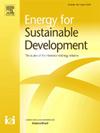In-situ performance investigation of the world's pilot canal top solar PV system in India
IF 4.4
2区 工程技术
Q2 ENERGY & FUELS
引用次数: 0
Abstract
Water-mounted solar photovoltaic systems offer significant advantages over traditional installations, but knowledge of their long-term degradation under extreme conditions, particularly sustained high humidity, remains limited due to their nascent stage of development. To address this gap, this study analyzes the decade-long degradation trend of the world's first canal-top SPV (CSPV) installation of its kind, situated in India. It also investigates system performance through in-situ characterization analysis employing Drone Thermography, String/module I-V, Electroluminescence, and Ultraviolet Fluorescence imaging techniques. The CSPV system exhibited an annual degradation rate of 1.30 % over the decade, with the best-fitted degradation trend described by the Langevin-based exponential model. Ethylene Vinyl Acetate browning affected nearly all CSPV modules, with the in-situ analysis revealing 14.98 % degradation at about 11 years of operation, exceeding expected degradation limits for most PV strings. Furthermore, increased occurrences of solder failure, bus-bar-related degradation, increased series resistance, elevated voltage degradation, and darker inactive regions towards negative polarity modules indicated metallization corrosion and early potential-induced degradation, highlighting the adverse impact of higher humidity. This research provides essential insights for design engineers, module manufacturers, and the maintenance team to quantify and address defects and anomalies in such systems, facilitating targeted actions for diagnosis and resolution.
世界试验运河顶级太阳能光伏系统在印度的现场性能调查
水基太阳能光电系统比传统装置具有显著的优势,但由于其发展的初级阶段,对其在极端条件下,特别是持续高湿度下的长期退化的了解仍然有限。为了解决这一差距,本研究分析了位于印度的世界上第一个运河顶SPV (CSPV)装置长达十年的退化趋势。它还通过使用无人机热成像、串/模块I-V、电致发光和紫外荧光成像技术的现场表征分析来研究系统性能。10年间,CSPV系统的年退化率为1.30%,其退化趋势由langevin指数模型描述。乙烯醋酸乙烯变褐影响了几乎所有的CSPV组件,现场分析显示,在大约11年的运行中,降解率为14.98%,超过了大多数PV串的预期降解极限。此外,焊料失效、母线相关劣化、串联电阻增加、电压劣化升高以及负极性模块上较暗的非活性区域的发生率增加,表明金属化腐蚀和早期电位诱发劣化,突出了较高湿度的不利影响。这项研究为设计工程师、模块制造商和维护团队提供了必要的见解,以量化和解决此类系统中的缺陷和异常,促进有针对性的诊断和解决措施。
本文章由计算机程序翻译,如有差异,请以英文原文为准。
求助全文
约1分钟内获得全文
求助全文
来源期刊

Energy for Sustainable Development
ENERGY & FUELS-ENERGY & FUELS
CiteScore
8.10
自引率
9.10%
发文量
187
审稿时长
6-12 weeks
期刊介绍:
Published on behalf of the International Energy Initiative, Energy for Sustainable Development is the journal for decision makers, managers, consultants, policy makers, planners and researchers in both government and non-government organizations. It publishes original research and reviews about energy in developing countries, sustainable development, energy resources, technologies, policies and interactions.
 求助内容:
求助内容: 应助结果提醒方式:
应助结果提醒方式:


